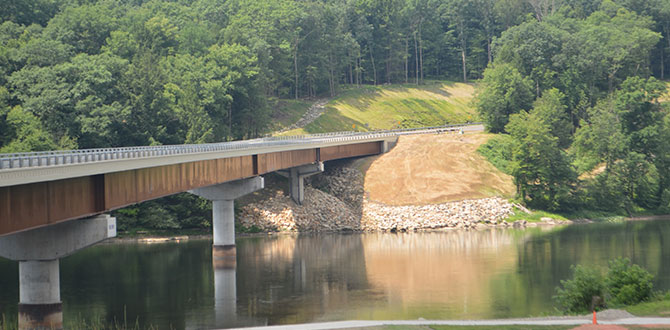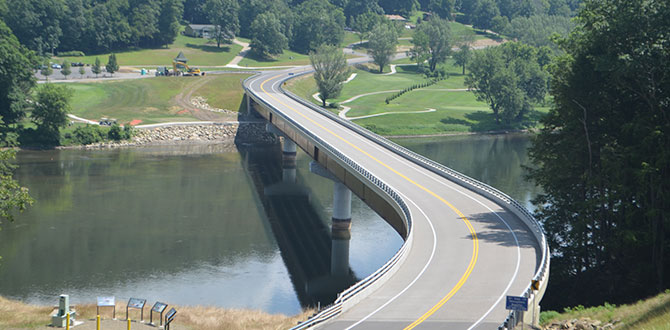Tionesta Township lies in Forest County, Pennsylvania, a rural area set along the western edge of the Allegheny National Forest. The Allegheny River, part of the National Wild and Scenic Rivers System, traverses southward through the township. As a protected resource, the river offers a rich and diverse ecosystem, which includes several threatened and endangered species of freshwater mussels.
Recently, we worked with the Pennsylvania Department of Transportation (PennDOT) District 1-0 to replace the circa-1934 Hunter Station Bridge, which crosses the Allegheny in Tionesta Township. Protection of the mussels was among the many constraints posed by this project. PennDOT challenged us to minimize impacts to the mollusks and provide a design that would be compatible with the recreational and aesthetic qualities of the river.

Balanced Solutions: Minimizing Environmental Impact
Many of our DOT clients are facing pressure today to blend design criteria, environmental sensitivity, context-sensitive features, and cost-effectiveness into transportation projects. The Hunter Station Bridge replacement project is one such example, with PennDOT requesting that we consider innovative ideas to find balanced project solutions. We sifted through many ideas and concepts—some ultimately not feasible or appropriate for this particular project—to discern the most cost-effective ways to minimize the environmental and site impact as much as possible while meeting design and constructability objectives. The most important takeaway for our team was recognizing the importance of a partnering approach that enabled us to resolve stakeholder concerns and build consensus through collaboration.
A Significant Conservation Effort
Our office had previously designed the West Hickory Bridge replacement, which crosses the Allegheny River nine miles to the north of the Hunter Station Bridge. As a result, we were familiar with the challenge of protecting the mussel population and the sensitive aquatic habitat. For the Hunter Station project, more than 130,000 mussels—representing 90 percent of the population at the site—were relocated to suitable habitats in six states. Through this effort, which involved a close partnership between the project team, PennDOT, and environmental agencies, the mussels’ range in the region has been significantly broadened, positioning the species for future removal from the threatened and endangered species list.
Other design measures will also help protect aquatic species in the river. We designed a bridge deck drainage system that discharges to infiltration beds along the river banks, reducing the potential for contamination of the water from road de-icing materials, fuel spills, and other hazards. The design also allowed for 350-foot interior bridge spans and single-shaft pier foundations that minimize the footprint and hydraulic impact of two of the piers in the river.
Advanced Safety Measures
Enhancing driver safety was also a top priority in the new design. Through the replacement effort, we were able to improve the horizontal approach curves and create wider lanes and shoulders. We also incorporated a high-friction surface treatment consisting of a special asphalt mix that improves traction. A beveled “safety edge” helps vehicles avoid road departure crashes.
Other highlights include a number of design features to minimize the need for extensive future maintenance, including a center-line girder that will allow for half-width redecking. We used weathering steel, architectural surface treatments, and native stone to obtain the approval of the U.S. Forest Service. An open-rail barrier allows for views of the river in both directions. At the southern end, a scenic overlook site provides information about Native American history along the river, the history of the Hunter Station Crossing, and the ecology of the river.

“An Innovative Project All Around”
The Hunter Station Bridge replacement project was recognized with a “Best Use of Technology and Innovation” award in the Northeast region of the America’s Transportation Awards. The jury noted the effort that went into the design and conservation planning, stating “In the end, not only did PennDOT build a new, structurally sound bridge for residents to avoid a very long detour, it included perhaps one of the largest conservation efforts for a single species in North America—an innovative project all around.”